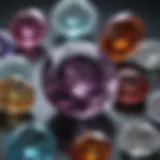Understanding the Unique Qualities of Green Diamonds
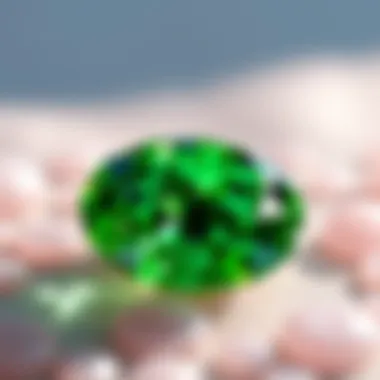
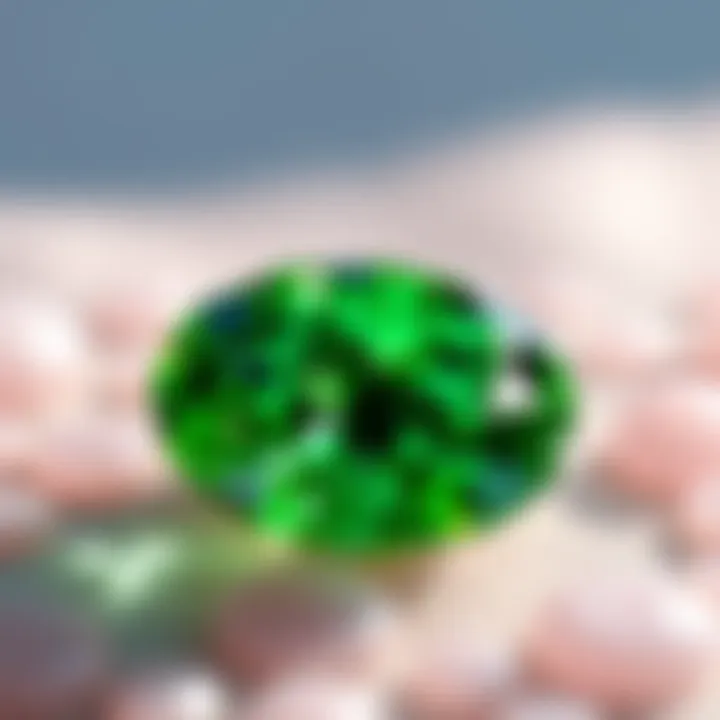
Intro
Green diamonds are a remarkable marvel among gemstones, often overlooked yet profoundly captivating. Unlike their more popular counterparts, such as traditional white diamonds, green diamonds boast a hue that's as rare as it is enchanting. Their color stems from an intricate blend of geological processes and environmental factors, setting them apart in a world where diamond variety is widely celebrated. This article unpacks not just the science behind these gems but also their rich cultural significance and unique properties, ultimately inviting gemstone enthusiasts and collectors to appreciate the nuances that green diamonds offer.
Overview of Gemstones and Minerals
History of Gemstone and Mineral Use
The fascination with gemstones dates back to ancient times. Different cultures have attributed various meanings and properties to them, often seen as symbols of power, beauty, and protection. For instance, the Egyptians adorned their pharaohs with lapis lazuli, while emeralds were favored by the Incas for their vibrant green hue. Green diamonds, though rarer in the historical narrative, represent a blend of mystique and allure, capturing the imagination of jewelers and collectors alike.
Significance in Culture and Society
Green diamonds hold a distinct place not only in the jewelry world but also in the broader cultural context. Across different societies, colors often carry symbolic weight. Green, associated with nature and renewal, imbues these diamonds with meanings linked to life, growth, and harmony. In many Asian cultures, they are seen as lucky stones, believed to bring prosperity and good fortune. Collectors value them not just for their beauty but also for the stories they carry, creating a unique blend of art and history.
Gemstone Formation and Properties
Formation Process of Gemstones
The creation of green diamonds involves a complex natural process that raises them from deep within the Earth. Formed under immense pressure and heat, these gemstones undergo metamorphosis over millions of years. Green coloring can result from exposure to natural radiation, unlike other diamonds whose colors may be formed during the crystallization process. Thus, they are not just gems; they are time capsules, holding the essence of the Earth's history.
Properties that Define Gemstones
Gemstones are evaluated based on several intrinsic properties, including hardness, refractive index, and luster. The Mohs scale, for instance, rates the hardness of diamonds at ten, making them some of the toughest substances on Earth. The unique properties of green diamonds, including their durability and unique lustrous shine, make them not simply a choice for wear but a significant investment for collectors.
Classification based on Color, Hardness, and Luster
When classifying gemstones, color is one of the most distinguishing factors. Green diamonds can range from vivid grass-green shades to pale green hues, influenced by their unique formation processes. Furthermore, diamonds are categorized into a few groups: precious (like diamonds and rubies) and semi-precious (such as amethysts). Interestingly, green diamonds straddle the fence, often categorized as precious due to their rarity.
Identifying and Evaluating Gemstones
Factors Affecting Gemstone Value
A variety of elements influences the value of green diamonds, including carat weight, clarity, and cut. The more intense the color and the fewer the inclusions, the higher the value tends to soar. Furthermore, the origin and history of the stone play a significant role, with prestigious sources fetching premium prices at auctions.
Techniques for Gemstone Identification
Identifying authentic green diamonds can be an intricate process. Gemologists often conduct thorough examinations using tools such as microscopes and spectrometers, analyzing the stone’s internal characteristics and light reactions. A comprehensive understanding of these techniques not only aids in valuation but also ensures that buyers acquire genuine gems, safeguarding against fraud.
Assessing Gemstone Quality
Quality assessment includes testing for brilliance, fire, and scintillation. A well-cut diamond reflects light brilliantly, creating an alluring sparkle that's hard to resist. Each facet must be precisely shaped to ensure an ideal balance between beauty and durability, something that's significantly crucial for green diamonds, which may already be lacking in numbers.
Caring for Gemstones
Cleaning and Storing Gemstones Properly
Proper care is paramount when owning green diamonds. Regular cleaning with mild soap and water, followed by a gentle brush, can keep your gems shining bright. Avoid harsh chemicals as they may dull the exquisite surface. Storing these stones in protective cases or soft pouches can also prevent scratches and damage.
Avoiding Common Mistakes in Gemstone Care
Many gem owners inadvertently make mistakes in care, such as exposing diamonds to extreme heat or sudden temperature changes. It’s important to handle such precious stones with utmost care. Additionally, engaging with professional services for cleaning can be a wise choice, ensuring the longevity of the stone.
Preservation Tips for Specific Gem Types
For green diamonds, special attention to their unique characteristics is essential. Given their rarity, securing a knowledgeable gem dealer for advice on preservation and storage will be beneficial. Regular inspections can help identify any issues early, keeping these cherished gems in top condition for years to come.
Green diamonds are not just beautiful; they are a slice of history, reflecting the earth's artistry and mystery.
Closure
In summary, an understanding of green diamonds opens up new avenues for appreciation among gemstone enthusiasts. By grasping the intricacies of their formation, properties, and cultural significance, collectors can not only enhance their knowledge but also garner greater enjoyment from their investments. Each green diamond tells a story, weaving connections through time and culture, making them a compelling addition to any gem collection.
Preface to Green Diamond Stones
Green diamonds are not just a rare fantastic piece of jewelry; they're often seen as the silent stunners in the world of gems. This introduction aims to spotlight the significance of these unique stones, not only from a geological standpoint but also their cultural relevance and increasing allure in the modern marketplace. The distinctive green hue, which makes them stand apart from their more common counterparts, holds a treasure trove of intrigue, heritage, and beauty.
Historical Context
The tale of green diamonds begins centuries ago when the fascination with colored gemstones was seen as mere fantastical whimsy. Unlike their traditional clear counterparts, green diamonds were often tossed aside due to their unusual color that could be construed as a mark of imperfection rather than an asset. Take for instance the famous Dresden Green Diamond, unearthed decades earlier in South Africa, this gem was the apple of its beholder's eye, symbolizing wealth and power, coveted by royals and collectors alike. In past centuries, green diamonds enjoyed modest recognition, regarded as almost magical, frequently associated with good fortune in various cultures.
Their historical significance provides a rich groundwork for gauging how these stones have evolved into objects of fascination in today’s contemporary settings, strikingly different from their past reputation. Many cultures viewed green gemstones as symbols of nature and renewal, often tied to the earth. A symbol of fertility in some cultures, in others, it indicated prosperity and spiritual healing, tying in their narratives deeply with the human experience throughout history.
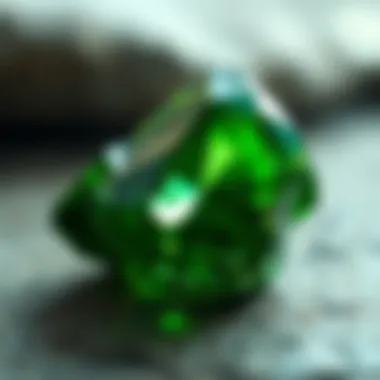
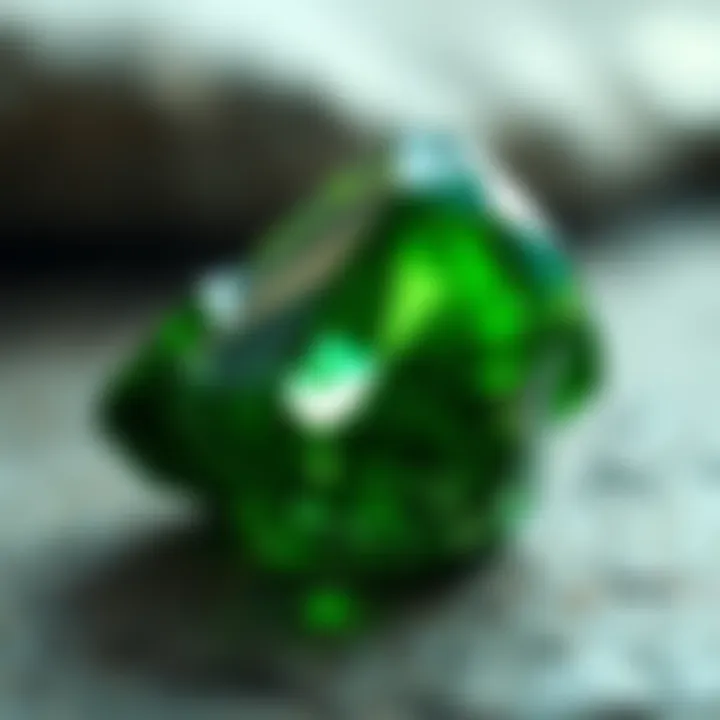
Modern Interest
Fast forward to the present day, green diamonds are making waves as the latest chic accessory for those who dare to step away from the bland. The new-age consumer—who often gravitate toward the uncommon—are increasingly raving about the distinctive green tones. Jewelers and collectors are not just slapping tags on these gems; they are instead diving deep into the stories woven behind each one.
The surge in demand for eco-conscious luxury goods has placed green diamonds in a favorable position. Sourcing these diamonds responsibly appeals to environmentally aware consumers which links the beauty of the stone directly to the beauty of sustainable practices. It’s like a hand-in-glove fit for many buyers today who want their jewelry to mean something beyond being aesthetically pleasing.
With significant advancements in gemology and jewelry design, green diamonds have emerged as a striking option for creative expression. In rings, necklaces, and bracelets, they capture the eye and the imagination, offering a fresh alternative to more traditional colorless diamonds.
Formation of Green Diamonds
The formation process of green diamonds is a crucial aspect of understanding these gemstones. Green diamonds are unique not just in their color but also in the distinct geological circumstances that lead to their creation. These gems represent an intersection of natural beauty and complex mineralogical phenomena, making them particularly fascinating for both gem enthusiasts and geology buffs.
Geological Processes
Green diamonds are birthed deep within the Earth’s mantle, at depths of about 150 to 200 kilometers. Here, carbon is subjected to extreme pressure and temperatures that reach up to 1,500 degrees Celsius. The formation of any diamond, green or otherwise, involves crystallization of this carbon over millions of years.
However, what sets green diamonds apart is the influence of specific geological processes. Unique tectonic movements and shifts contribute significantly to the conditions required for their formation. For instance, the intrusion of magma can create zones within kimberlite pipes that have the necessary heat and pressure for diamond formation.
Thus, the geological processes forming green diamonds are not merely standard; they are often localized and rare. This rarity adds to their value and intrigue.
Natural Irradiation
The green hue of diamonds often results from natural irradiation. When diamonds are exposed to radioactive materials in their surrounding environment for an extended period, the radiation alters the crystal lattice structure of the diamond, resulting in the characteristic green color.
While some diamonds can achieve a green tint through other means, such as synthetic treatments, the natural irradiation process lends an authenticity and depth to the color of green diamonds. It’s this natural alteration rather than artificial processes that gemologists often look for because it can indicate the diamond's origin and history—a crucial factor for collectors and investors alike.
Comparative Formation
In comparing the formation of green diamonds to their colorless counterparts, the unique factors involved become more evident. Colorless diamonds primarily form through a more straightforward crystallization process without significant external radiation exposure. In contrast, the intricate dance of geological conditions, along with the irradiation incident to green diamonds, means they are less common.
The methods that create different colored diamonds often vary widely and are more influenced by the presence of different elements or trace materials during the crystallization stage. For instance, blue diamonds get their color from boron impurities, while yellow diamonds are colored by nitrogen. Green diamonds, however, witness a combination of factors that lead to their unique appearance, making them a topic of interest not just for buyers but also for researchers and educators.
"A diamond's true beauty often lies deeper than its surface, and understanding its formation reveals the intricate story behind its journey through time."
Understanding the formation of green diamonds is not just about appreciating their beauty. It’s a deeper inquiry into the Earth’s geological processes and the effects of nature on carbon in unique conditions. These factors play a significant role in determining the rarity and desirability of the stone, offering insights that continue to attract and educate gemstone enthusiasts and collectors.
Physical and Chemical Properties
Understanding the physical and chemical properties of green diamond stones is crucial for a comprehensive grasp of what makes these gems truly special. Beyond their surface-level allure, these attributes influence everything from their market valuation to how they are crafted into stunning jewelry. Let’s delve deeper into the components that make these green marvels stand out in the world of gemstones.
Crystal Structure
The crystal structure of green diamonds primarily belongs to the isometric system, which means they have a high level of symmetry. This characteristic not only contributes to their sparkling brilliance but also plays a vital role in their durability. Each individual carbon atom is intensely bonded to four others, creating a network that is extremely resilient. This structural configuration enables green diamonds to withstand pressure and resist scratches, far surpassing many other gemstones.
In addition, when studying the green diamond's crystal lattice, one can notice the presence of nitrogen, which often contributes to their unique hue. Although yellow diamonds often exhibit a yellow tinge due to nitrogen, in green diamonds, the absorption spectrum can change because of the natural irradiation they undergo. Therefore, the structural intricacies not only define their physical strength but also the reasons behind their captivating colors.
Color Variations
Green diamonds are perhaps best known for the fascinating variety of shades they can exhibit. Ranging from light green to deep forest hues, the intensity of the color often corresponds to the level of radiation exposure the diamond has experienced. For instance, faint green diamonds might present a gentle tint, while vivid greens can command higher prices in the market.
Interestingly, some green diamonds display a secondary color, such as a yellowish or bluish undertone, adding layers to their allure. Factors that determine these nuances include the diamond's origins and the length and intensity of the natural radiation process that formed it.
Their distinct color is often categorized as the following:
- Fancy Light Green: A soft, subtle hue that appeals to those who prefer understated elegance.
- Fancy Intense Green: A more robust color, striking enough to catch attention while still remaining sophisticated.
- Fancy Deep Green: This hue embodies boldness, often capturing the eye of collectors who appreciate its rarity and depth.
Hardness and Durability
One of the reasons diamonds are so revered is their hardness, leading them to be rated as a perfect 10 on the Mohs scale. Green diamonds, like other diamonds, possess this hardness due to their strong atomic bonds, making them an excellent choice for everyday jewelry. However, while they can resist common scratches and wear, they are not indestructible.
Their durability takes on significant importance for those interested in jewelry craftsmanship. Designers need to consider how both hardness and brittleness can impact the setting of green diamonds. For instance, a poorly executed setting could lead to potential risks during wear or cleaning.
Here are some practical tips for ensuring the longevity of green diamond jewelry:
- Avoid exposure to harsh chemicals that might dull their sheen.
- Regularly inspect settings for wear and tear.
- When cleaning, employ a gentle approach with tools that won’t scratch their surface.
Understanding these physical and chemical aspects sets the foundation for appreciating green diamonds from a both aesthetic and scientific viewpoint, making them undeniably fascinating gems.
Comparison with Other Diamonds
When examining the world of gemstones, it’s key to understand how green diamonds stack up against their more commonly known counterparts. This comparison lays the groundwork for appreciation and understanding of their nuances and intricacies.
Other Fancy Colors


Green diamonds belong to a vibrant family, often joined by blue, pink, and yellow diamonds within the category of fancy colors. Each of these stones presents unique attributes and appeals. For instance, blue diamonds, infused with boron, exhibit their own mesmerizing hues, often drawing high prices at auctions. Similarly, pink diamonds owe their rare color to a deformation in their crystal lattice structure.
But what sets green diamonds apart isn’t just their color; it’s the backstory behind it. Natural green diamonds derive their color from radiation exposure in the earth, which is a distinct process compared to how other fancy colors form. This radiation gives green diamonds a remarkable depth and character — a tale written in the stone itself.
- Rarity: The combination of their unique formation and the limited sources contribute to green diamonds being less commonly found than blue or pink diamonds.
- Perception: While blue and pink diamonds often capture the limelight in high-profile jewelry pieces, green diamonds have been slowly gaining recognition.
Price Points
Green diamonds occupy an intriguing space in the price spectrum of gemstones. The market values can swing significantly, influenced by factors such as carat weight, clarity, and, crucially, the intensity of the green color. On average, gemstones like vivid green diamonds can command prices comparable to their blue and pink counterparts. However, they still often lag behind these more established fancy colors in terms of recognition and pricing.
- Market Trends: The beauty of green diamonds is finally being recognized, leading to an upward trend in their prices.
- Bargains: For those astute collectors, lesser-known green diamonds can represent a wise investment, offering a blend of beauty and potential appreciation.
It’s essential to consider these elements if one is navigating the complex landscape of diamond valuations.
Unique Market Considerations
In the world of diamonds, market dynamics can be as perplexing as the gems themselves. For green diamonds, a few unique factors come into play that are worth noting. Firstly, marketing and public perception play pivotal roles. For years, green diamonds had been overshadowed by their pink and blue cousins, making their transition into mainstream jewelry longer and more challenging.
Additionally, sourcing remains a critical concern. Ethical sourcing of diamonds is at the forefront of today’s market discussions. Consumers are increasingly making choices based on the origins of stones. Green diamonds are often linked with arguments around sustainable mining practices, which can positively influence their market standing in a growingly ethical-conscious world.
- Emerging Trends: As awareness regarding the existence and beauty of green diamonds grows, expect to see an increase in bespoke jewelry designs that highlight these unique stones.
- Investment Potential: The potential for appreciation in value is unique for green diamonds due to their rarity combined with a growing interest from collectors.
In summary, the comparison with other diamonds illuminates not just the inherent qualities of green diamonds but situates them within the broader context of gemstone appreciation. For collectors and enthusiasts, understanding these dimensions can enhance their engagements with these singular gems.
Cultural Significance
Understanding the cultural significance of green diamonds adds depth to their allure. These stones are not just prized for their beauty; they carry meanings that span across various cultures and traditions. The way people relate to these gems reveals insight into social values, beliefs, and even aspirations. By examining their symbolism and presence in literature and art, we learn about the enduring impact of green diamonds beyond their physical charm.
Symbolism in Various Cultures
Green in many cultures is often associated with prosperity and abundance. The green diamond, as a manifestation of this color, has taken on rich layers of meaning through the ages. In some cultures, it symbolizes growth, renewal, and fertility. The ancient Egyptians believed that green stones were linked to life and growth, associating them with the divine powers of regeneration. To them, placing a green stone in tombs ensured the resurrection of the deceased.
In Western cultures, green has often been linked to envy and jealousy, termed "the green-eyed monster." Contradictorily, a green diamond worn as a piece of jewelry may symbolize wealth and success, allowing the wearer to embrace a duality that few gems can offer. Surprisingly, not all cultures view these meanings similarly; in some cases, green is also tied to tranquility and stability, suggesting a meditative quality to the green diamond's essence.
In Asian cultures, specifically in China, green symbolizes harmony and balance. The association of jade with these concepts enhances the significance of green-colored gemstones. When a person wears a green diamond, it can resonate as a beacon of peace and calm, fostering relationships and social harmony.
"Green diamonds symbolize a blend of wealth and growth, inviting the wearer to indulge in the richness of life while cultivating personal and communal opportunities."
Presence in Literature and Art
The allure of green diamonds hasn’t escaped the gaze of creators across time. In literature, these stones often pop up in narratives intertwined with themes of loss and redemption, serving as metaphors for personal journeys. One can find green diamonds in stories symbolizing hope or the idea that something beautiful can emerge from darkness. For instance, in the realms of classic literature, characters may find solace or insight as they pursue these rare stones, each representing a different facet of human experience.
Artistic representations of green diamonds in paintings or sculptures often evoke a sense of mystery and wonder. Artists have long been inspired by the unique hues and the play of light that these stones can exhibit. Noteworthy modern pieces in galleries would showcase green diamonds as more than mere adornments; they become central motifs, exploring themes of existence and nature through their vibrancy.
In sum, the presence of green diamonds in artistic mediums demonstrates how these stones transcend their physical properties, serving as symbols of aspiration, beauty, and the complexity of human emotion. This highlights their significance not only in jewelry but also in the collective consciousness of various societies.
Through all these examples, it becomes clear that green diamonds are more than precious stones; they are vibrant storytellers woven into the fabric of cultures, stirring imagination and inspiring countless narratives.
Sourcing and Ethical Considerations
The narrative of green diamond stones entails a responsible discussion regarding their sourcing and the ethical dimensions that accompany their journey from earth to market. Especially in the gem industry, where charming aesthetics often mask grim realities, understanding these elements becomes increasingly crucial for informed consumers and collectors. This section highlights essential facets including mining practices, the impact on local communities, and the role of certification standards in ensuring ethical compliance.
Mining Practices
Green diamonds, like many precious stones, emerge from mining operations that can vary significantly in their methodologies. Some mines employ large-scale mechanized techniques that may cause substantial environmental degradation, while others utilize artisanal methods that sustain local economies. Responsible mining practices aim to strike a balance between extracting value and protecting the environment.
For instance, sustainable mining practices focus on:
- Utilizing technology that minimizes ecological footprints
- Ensuring safe working conditions for miners
- Engaging in reclamation efforts to restore mined land
These practices not only help safeguard natural habitats but also ensure that miners receive fair wages and work in humane conditions. In the quest for ethical sourcing, it’s vital to scrutinize the mining practices of companies involved with green diamonds.
Impact on Local Communities
The implications of mining extend beyond environmental concerns; they profoundly influence local communities. In regions where green diamonds are mined, such as in parts of Africa and South America, the socio-economic fabric often faces disruption. On one hand, mining activities can bring economic opportunities, such as job creation and infrastructure development. On the other hand, there exists a risk of exploitative practices, where communities derive little benefit from the riches extracted from their lands.
To gauge the real impact, it’s important to consider:
- Beneficiary frameworks: Are profits benefiting the community?
- Community engagement: Do companies involve locals in decision-making processes?
- Resilience measures: Are communities prepared for socio-economic fluctuations related to mining?
Understanding this interplay helps potential buyers appreciate the larger picture, guiding them toward informed purchasing decisions that support communities positively.
Certification Standards
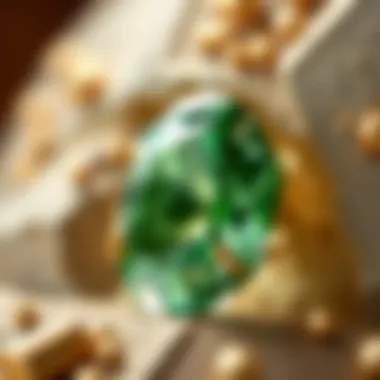
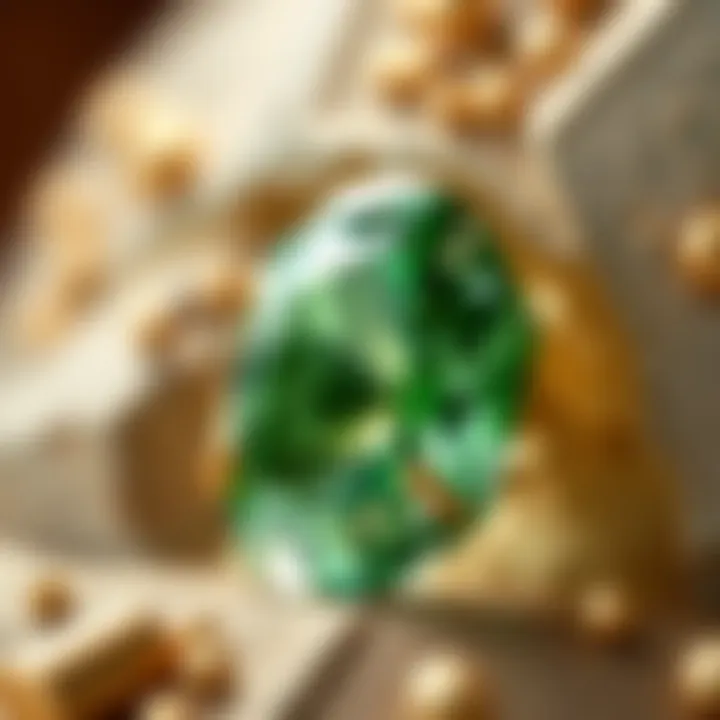
As ethical consumption becomes a prevalent theme, certification standards serve as a beacon for discerning buyers of green diamonds. These frameworks ensure that gems are sourced humanely, minimizing exploitation and environmental damage. Organizations such as the Responsible Jewellery Council and the Gemological Institute of America enforce stringent criteria that certified diamonds must meet.
Critical points include:
- Verification of ethical mining practices
- Proof of fair trade initiatives
- Commitment to environmental sustainability
By prioritizing certified options, consumers can make choices that align with their values. Furthermore, awareness and advocacy for certification standards empower buyers to demand transparency, helping erode the dark side of the diamond industry and fostering a market more aligned with ethical norms.
Caring for Green Diamonds
Caring for green diamonds is an essential aspect of ownership that not only maintains the gem’s brilliance but also protects your investment. These stones, while intriguing in their hue, can demand particular attention due to the unique economical and aesthetic values associated with them. Proper care techniques can preserve their stunning qualities and ensure they pass the test of time. Each diamond stands as a testament to nature's artistry, so it's only fitting that they receive care reflective of their significance.
Cleaning Practices
Keeping your green diamond impeccably clean enhances its natural beauty. Basic cleaning is often easier than most people realize. Here's a straightforward approach to consider:
- Use Mild Soap and Water: Mix a drop of mild dish soap with lukewarm water. Soak a soft, lint-free cloth and gently wipe your diamond. This step aids in removing daily grime without risking scratches or damage.
- Avoid Harsh Chemicals: It’s tempting to use powerful cleaning products, but beware! Such chemicals can damage the surface and settings of the diamond.
- Use a Soft Brush for Settings: If your diamond is set in a piece of jewelry, a soft toothbrush can effectively remove dirt from the small crevices. This is particularly useful for intricately designed settings.
- Rinse Thoroughly: After cleaning, ensure you rinse the diamond under lukewarm running water. Just remember to do this over a bowl or sink strainer to avoid any slip-ups.
"Regular cleaning not only maintains the sparkle of green diamonds but also ensures any potential damage from dirt buildup is kept at bay."
Storage Tips
Proper storage can prolong the life and luster of your green diamond. Mistakes in storage can lead to scratches, tarnishing, or other forms of damage. Here’s what to keep in mind:
- Keep it Separate: Store your diamond away from other jewelry pieces. The last thing you want is for it to be scratched by a rougher surface.
- Use Soft Pouches or Dividers: When storing your diamonds in a jewelry box, consider individual soft pouches or dividers. This minimizes risk and helps in maintaining their condition.
- Ideal Environment: Ensure that your storage area is cool, dry, and dark. Moisture and direct sunlight can harm many gemstones, including your cherished green diamond.
- Frequent Check-Ups: Make it a habit to check your diamond every so often. This way, you can catch any issues before they become significant concerns.
By adopting these simple yet effective cleaning and storage practices, collectors and enthusiasts can ensure their green diamonds continue to dazzle for generations to come.
Jewelry Design and Trends
The world of jewelry design is an ever-changing landscape, and green diamond stones offer a unique and vibrant twist in this realm. Their rarity and distinct color make them not just pieces of jewelry, but statements of individuality. In this section, we'll uncover how green diamonds are incorporated into designs and what trends are currently shaping the market.
Current Market Trends
Jewelry trends often reflect broader societal shifts and consumer preferences. The interest in eco-friendly and sustainably sourced materials has grown significantly over the years, and green diamonds fit perfectly into this narrative. An increasing number of people are looking for gemstones that carry a story with them, and green diamonds, forged deep within the Earth's crust, bring a natural history that resonates with buyers.
The popularity of online shopping has transformed how consumers engage with jewelry. Customization is king. Shoppers are moving towards individual designs that showcase personal style rather than mass-produced pieces. Green diamonds are particularly attractive for bespoke designs because their unique hue can align with various metals and styles, from vintage to modern.
Moreover, there’s a discernible trend toward stacking rings and mixed-metal designs, where green diamonds are often featured in combinations with other gemstones. This allows the subtle green tones to emerge beside softer gems like morganite or the bold contrasts with a black diamond, thus creating visually striking compositions.
Design Considerations
When it comes to integrating green diamonds into jewelry, several design aspects should be considered:
- Color Harmony: Green diamonds are not just a standalone color; they come in varying shades from yellowish-green to deep, rich green. Designers must carefully select complementary or contrasting colors to highlight the diamond’s natural beauty.
- Cut and Clarity: Selecting the right cut is vital. A well-faceted green diamond can catch the light in spectacular ways, enhancing its overall appeal. Clarity also plays a role, as inclusions can affect how the stone appears in different lighting.
- Metal Settings: The choice of metal can drastically alter the look of the piece. Traditional yellow gold can warm the green tones, while white gold or platinum can lend a contemporary edge, making the diamond pop.
- Cultural Influences: Incorporating elements from various cultures can enrich the design. For instance, some designers draw inspiration from traditional motifs, weaving stories and history into the jewelry.
"Jewelry should not just adorn; it should express the wearer's journey, and green diamonds certainly have a tale to tell."
In summary, the interplay of current market dynamics and thoughtful design considerations is shaping how green diamonds are featured in contemporary jewelry. As tastes evolve and sustainability takes center stage, these gemstones are poised to continue captivating enthusiasts and collectors alike.
Rare and Notable Examples
In the realm of precious gemstones, the allure of green diamond stones goes hand in hand with their rarity and the notable examples that surface in history and modernity. It’s not just about the individual stones, but rather the narratives they carry with them, stitched into the fabric of both geology and human culture. Understanding these exceptional finds can illuminate the broader appeal of green diamonds, showcasing their significance beyond mere aesthetics.
Historical Finds
Historically, green diamonds have been the stuff of legends. One particularly striking example is the Dresden Green Diamond, a stunning gemstone weighing around 41 carats, which dates back to the 18th century. Housed in the Green Vault of Dresden, Germany, this diamond’s rich history is a testament to its intrigue. Its unique color is a result of natural irradiation processes, which makes it a scientific marvel as much as it is a gem. The stone is steeped in tales of various owners, royals, and admirers, illustrating how precious gems often become vessels of human stories.
Another notable historical find is the Imperial Green Diamond, which had a captivating journey from India to the West. Belonging to the Mughals, the diamond later made its way into the collection of a wealthy European aristocrat. Such stories add layers of significance to gemstones, making them valuable not only for their visual characteristics but also for their connections to cultural and historical narratives.
Contemporary Auctions
As our fascination with green diamonds continues to thrive, contemporary auctions present fresh opportunities for collectors and investors alike. Recent auctions have shown a growing trend toward these stones, with some pieces fetching jaw-dropping prices. For instance, at a recent Christie’s auction, a green diamond ring estimated at over a million dollars captured the attention of enthusiasts and collectors from around the world, proving that the market for these rare gems is not just alive, but robust.
Moreover, auction houses are increasingly spotlighting green diamonds due to their scarcity. While colorless diamonds are plentiful, green diamonds offer a unique investment opportunity. The rise in demand is visible in the bidding wars that often take place. This indicates a shifting landscape in gemstone investment strategies, suggesting that savvy collectors are recognizing the potential for value appreciation in these vivid stones.
"The rarity of green diamonds, coupled with their distinct coloration and unique history, transforms them from mere gems into noteworthy investment assets."
In both historical context and contemporary settings, the examples of green diamonds hold a mirror to society’s changing values and interests regarding luxury and beauty. From being adored by royalty to commanding attention in today’s high-profile auctions, these stones encapsulate narratives that resonate across ages, affirming their place in the world of gemstones.
Closure
As we wrap up our exploration into the world of green diamond stones, it becomes clear that their significance stretches beyond mere aesthetics. These gems embody a mixture of geological marvel, cultural narratives, and environmental considerations that appeal to both gemstone enthusiasts and collectors alike.
The Future of Green Diamonds
Looking ahead, the future of green diamonds seems to gleam with promise yet also challenges. Their rarity and unique properties will likely continue to fascinate buyers; however, with the growing emphasis on ethical sourcing and sustainable practices, the market might shift in ways we are only beginning to understand. Consumers are becoming increasingly aware of how their purchasing choices impact the world around them. Therefore, there's potential for a rise in demand for certified gems—those that come with a guarantee of responsible sourcing.
Moreover, advancements in technology may lead to more effective processes of artificial irradiation, simulating the natural process while ensuring ethical standards are met. This could introduce a new segment of green diamonds into the market, providing options for those who appreciate the aesthetic without the ethical dilemmas.
